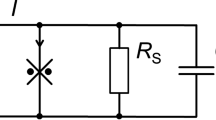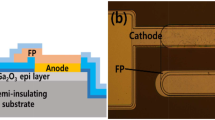Abstract
SRON is developing ultra-low-noise transition edge sensors (TESs) based on a superconducting Ti/Au bilayer on a suspended SiN island with SiN legs for SAFARI aboard SPICA. We have two major concerns about realizing TESs with an ultra-low NEP of \(2\times 10^{-19}~\hbox {W}/\sqrt{{\text {Hz}}}\): achieving lower thermal conductance and no excess noise with respect to the phonon noise. To realize TESs with phonon-noise-limited NEPs, we need to make thinner (\({<}0.25~\upmu \hbox {m}\)) and narrower (\({<}1~\upmu \hbox {m}\)) SiN legs. With deep reactive-ion etching, three types of TESs were fabricated in combination with different SiN island sizes and the presence or absence of an optical absorber. Those TESs have a thin \((0.20~\upmu \hbox {m}\)), narrow (0.5–0.7 \(\upmu \hbox {m}\)), and long (340–460 \(\upmu \hbox {m}\)) SiN legs and show \(T_{\mathrm {c}}\) of \({\sim }93~\hbox {mK}\) and \(R_{\mathrm {n}}\) of \({\sim }158~\hbox {m}{\Omega }\). These TESs were characterized under AC bias using our frequency-division multiplexing readout (1–3 MHz) system. TESs without the absorber show NEPs as low as \(1.1\,\times \,10^{-19}~\hbox {W}/\sqrt{{\text {Hz}}}\) with a reasonable response speed (\({<}1~\hbox {ms}\)), which achieved the phonon noise limit. For TESs with the absorber, we confirmed a higher \(\hbox {NEP}_{\mathrm {el}} ({\sim }5\,\times \,10^{-19}~\hbox {W}/\sqrt{{\text {Hz}}}\)) than that of TESs without the absorber likely due to stray light. The lowest NEP can make the new version of SAFARI with a grating spectrometer feasible.





Similar content being viewed by others
References
W.S. Holland et al., Proc. SPIE 6275, 62751E (2006)
P. Khosropanah et al., AIP Conf. Proc. 1185, 42 (2009)
P. Khosropanah et al., IEEE Trans. Appl. Supercond. 21, 236 (2011)
P. Khosropanah et al., ISSTT2011 Proceedings, vol. 125 (2011)
P. Khosropanah et al., J. Low Phys. 167, 188 (2012)
J. Mather, Appl. Opt. 21, 1125 (1982)
T. Suzuki et al., IEEE Trans. THz Sci. Technol. 42, 171 (2014)
P. Khosropanah et al., J. Low Phys. 176, 363 (2014)
M.L. Ridder et al., J. Low Temp. Phys. (2015). doi:10.1007/s10909-015-1381-z
R.A. Hijmering et al., J. Low Temp. Phys. (This Special Issue)
L. Gottardi et al., J. Low Temp. Phys. 167, 161 (2012)
L. Gottardi et al., Appl. Phys. Lett. 105, 162605 (2014)
A.D. Beyer et al., Proc. SPIE 8452, 84520G (2012)
T.O. Klaassen et al., ISSTT2012 Proceedings, vol. 400 (2012)
Acknowledgments
The authors are thankful to Damian Audley and Gert de Lange for scientific discussions, and Martijn Schoemans and Kevin Ravensberg for the technical support.
Author information
Authors and Affiliations
Corresponding author
Rights and permissions
About this article
Cite this article
Suzuki, T., Khosropanah, P., Ridder, M.L. et al. Development of Ultra-Low-Noise TES Bolometer Arrays. J Low Temp Phys 184, 52–59 (2016). https://doi.org/10.1007/s10909-015-1401-z
Received:
Accepted:
Published:
Issue Date:
DOI: https://doi.org/10.1007/s10909-015-1401-z




